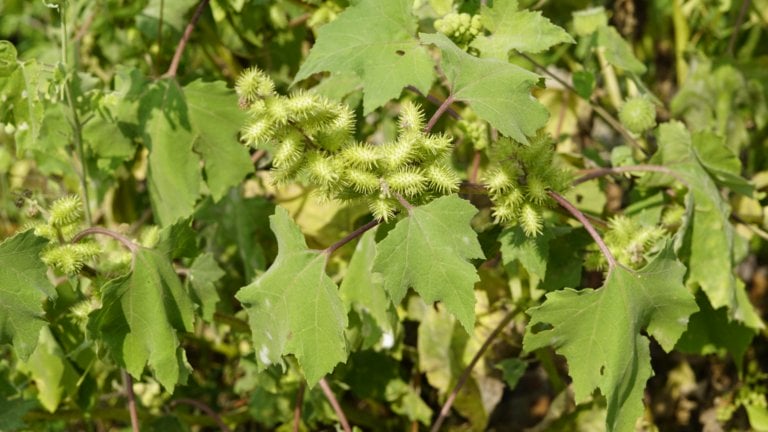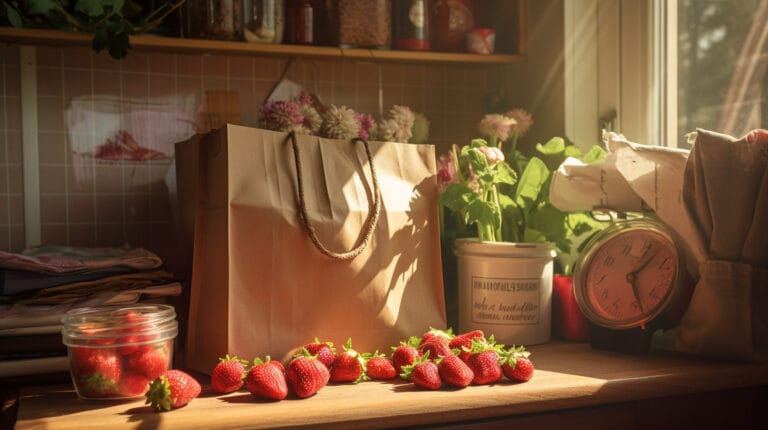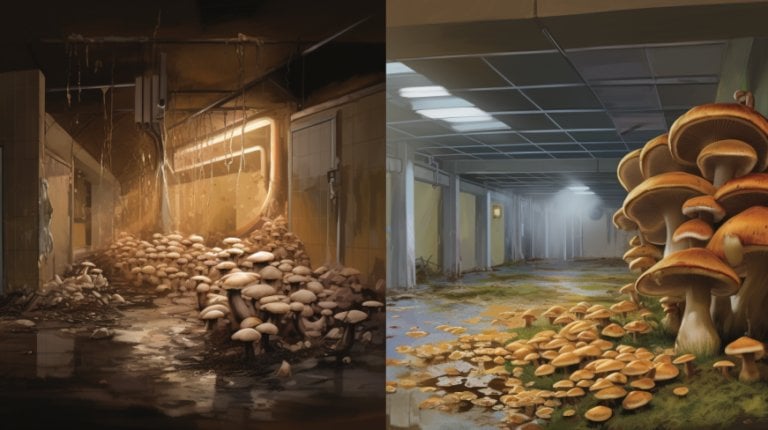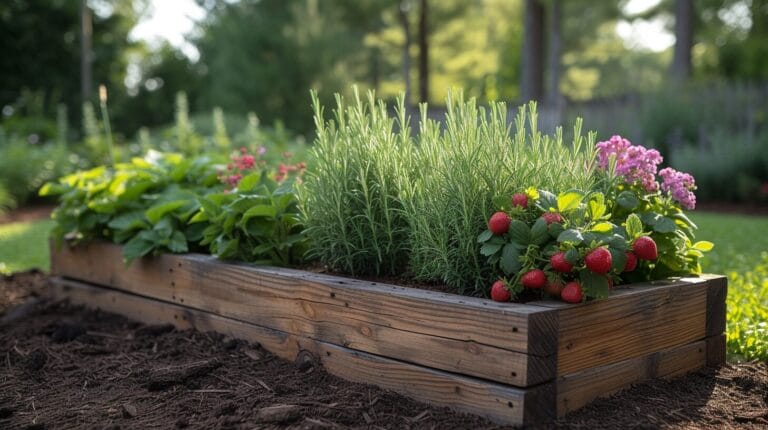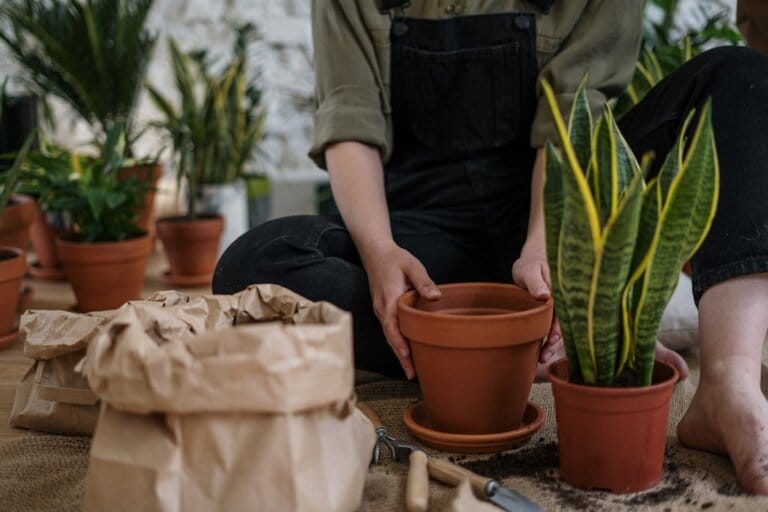Planting Herbs and Flowers Together in Pots: A Quick Fusion in Garden
I’ve discovered the marvel of companion planting. It extends beyond merely being a strategy for saving space, it nurtures a thriving ecosystem as well.
I will share what I’ve learned about planting herbs and flowers together in pots. We’ll cover the basics: choosing the right pots, selecting the best plants, and how to maintain your little garden.
Let’s dive in, shall we?
Key Takeaways
- Companion planting creates a micro-ecosystem where plants work together to thrive.
- Herbs and flowers planted together can deter pests and improve soil health.
- Certain herb and flower combinations can enhance the growth and flavor of vegetables.
- Companion planting offers a natural and chemical-free method of pest control.
Understanding the Basics of Companion Planting
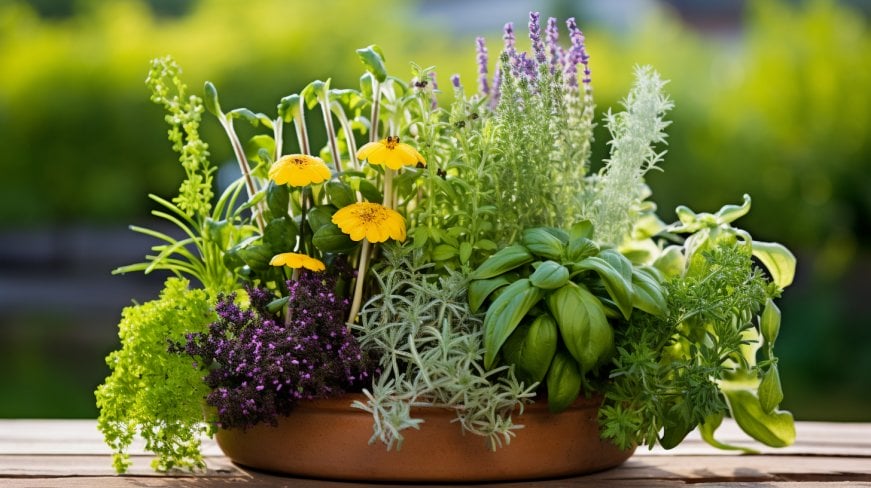
Let’s learn the basics of companion planting, which can make your garden thrive.
It’s fascinating to find out why herbs and flowers often grow better together.
Plus, we’ll explore how this clever planting strategy can help control pests in your garden.
The concept and benefits of companion planting
I will delve into the concept of companion planting. This method offers numerous benefits when planting herbage and flowers together in pots. This practice is not just about aesthetics. It’s about creating a micro-ecosystem where the plants work together to flourish. Some herbs thrive together, enhancing each other’s growth and flavor.
| Herb and Flower Combinations | Benefits of Companion Planting |
| Basil and Marigold | Marigold deters pests, Basil enhances growth |
| Chamomile and Daisies | Chamomile improves flavor, Daisies attract pollinators |
| Petunias deter pests, and mint promotes growth | Lavender deters pests, Rosemary attracts pollinators |
| Mint and Petunias | Petunias deter pests, mint promotes growth |
Companion planting herbs with flowers can create a vibrant, aromatic, and beneficial pot that thrives. Use this method to maximize the health and yield of your potted garden.
Why herbs and flowers grow well together
Now, we will explore why herbs and flowers grow so well together by understanding the basics of companion planting.
The idea behind companion planting is that certain plants when grown together, can benefit each other greatly. This applies when you’re planting herbage and flowers together in pots, too.
Certain herbs and flowers grow well unitedly because they help each other by deterring pests, improving soil health, and boosting each other’s growth. For instance, marigolds planted with herbs can ward off insects.
Similarly, herbs can be planted together with vegetables in a process called companion planting vegetables to enhance their growth and flavor.
This is the beauty of nature’s symbiosis right in your pots!
Impacts of companion planting on controlling garden pests
I’ve discovered that companion planting has two primary benefits: the plants can enhance each other’s growth, and, importantly, they can also help control garden pests. When planting herbage and flowers together in pots, the aromatic nature of herbs can deter many pests, creating a natural and chemical-free method of pest control.
Here are three significant impacts of companion planting:
1. Pest Deterrence: Certain herbs emit strong scents that repel common garden pests.
2. Improved Health: Plants help each other to grow, reducing the chances of pest infestation.
3. Biodiversity: The plant variation attracts beneficial insects, natural predators of garden pests.
Choosing the Right Pots for Your Companion Garden

Now, let’s focus on selecting the perfect pots for our companion garden.
Size, drainage, and material are all critical elements in pot selection.
We’ll discuss how these factors can influence the success of your herbs and flowers and help you make the best choice for your garden.
Importance of selecting the correct pot size
Choosing the right pot for your companion garden is a crucial step that I can’t emphasize enough, as it largely affects the growth and health of your plants. When discussing herbs in pots, selecting the correct pot size is paramount.
1. Size Matters: A pot that’s too small will restrict root growth, limiting the plant’s ability to absorb nutrients and water.
2. Proper Drainage: The right-sized pot ensures proper drainage, preventing waterlogged roots, which can cause diseases.
3. Room for Companionship: If you plan to plant more than one herb or flower in a single container, a larger pot will provide ample space for all plants to thrive.
Understanding the drainage needs of herbs and flowers
In my experience, understanding the drainage needs of herbs and flowers starts with selecting pots that allow for adequate water flow, thereby preventing the risk of waterlogging or, in the extreme, root rot. When planting herbage and flowers together in pots, it’s crucial to choose containers with sufficient drainage holes. These ensure that water doesn’t stagnate in the soil, which could harm your container plants.
Here’s a simple table to illustrate the drainage needs of some common herbs and flowers:
| Herbs/Flowers | Drainage Requirement | Ideal Pot Material |
| Basil | High | Terracotta |
| Marigolds | Moderate | Plastic |
| Rosemary | High | Terracotta |
| Petunias | Moderate | Plastic |
Material selection for pots based on plant requirements
I’ve discovered several factors to consider when selecting the right pot material for your companion garden.
1. Durability: Some materials weather better than others. For instance, terracotta can crack in cold weather, but plastic or resin pots tolerate temperature shifts better.
2. Weight: If you’re planting herbage together and moving them regularly, lightweight materials like plastic or fiberglass are best. Stone or ceramic pots are heavier but provide stability for larger herbs and flowers together in pots.
3. Insulation: The material selection for pots should also consider insulation. Metal pots heat up quickly, potentially damaging roots, while wood or terracotta offers better insulation.
Understanding these plant requirements for pot herbs will ensure a thriving, beautiful companion garden.
Selecting The Best Herbs and Flowers for Companion Planting

Now, let’s focus on choosing the best herbs and flowers for companion planting.
We’ll first look at the top perennial herbage that harmonizes well with flowers.
Then, we’ll discuss the ideal types of flowers that thrive alongside herbs and the conditions, such as full sun or shade, that influence these combinations.
Top perennial herbs that work well with flowers
Let’s delve into the top perennial herbs that pair exceptionally well with flowers for companion planting.
1. Rosemary – This perennial herb isn’t just a kitchen staple but also a great flower companion. Its strong scent deters pests, protecting delicate blooms nearby.
2. Chives – Chives are herbs that grow well together with flowers, such as roses, enhancing their growth while adding a beautiful touch of purple.
3. Mint – Mint’s vigorous growth can be controlled by planting in pots, making it an ideal companion for many flowers.
Mastering the art of planting herbage and flowers together in pots opens up a world of beauty and practicality. Remember, the key is to select top perennial herbs that work well with flowers, creating a harmonious flower and herb garden.
Ideal types of flowers that thrive best with herbs
In this section, I’ll delve into the ideal types of flowers that thrive best when planted with herbs, and I’ll provide some tips on selecting the best combinations for companion planting.
Marigolds are among the best flowers to plant with herbs. Their bright colors not only beautify your garden but also attract pollinators, improving your herb’s health and productivity.
Additionally, Nasturtiums blend well with herbage and flowers together in pots due to their ability to repel pests.
Lavender, on the other hand, is a fantastic choice that draws beneficial insects and provides a delightful fragrance.
Conditions that dictate herb and flower combinations (full sun, shade, etc.)
I’m about to explore how environmental conditions, such as well-lit exposure or shade, can greatly influence the success of your herb and flower pot combinations.
1. Full sun: Certain herb and flower combinations, like Rosemary and geranium, thrive in well-lit. They need at least 6 hours of direct sunlight every day.
2. Partial sun/shade: Some herbs and flowers prefer less intense sun. Combinations like mint and impatiens do well in these conditions, making them perfect for planting herbage and flowers together in pots in partially sunny spots.
3. Full shade: Believe it or not, there are herb and flower combinations that can survive in full shade. Parsley and begonias are examples of herbs and flowers in shade.
Planting Herbs and Flowers Together in Pots

Let’s discuss how to successfully plant herbage and flowers together in the same container.
We’ll prepare the pot for planting and then arrange the plants for optimum growth.
We’ll wrap things up by addressing the sustenance requirements of your tubbed herbs and flowers.
Preparing the pot for planting
Before we delve into the planting specifics, I must explain how to properly prepare the pot for a harmonious cohabitation of herbs and flowers.
1. Select the right container: Picking the correct pot is the first step. It should be large enough to accommodate the herbs and flowers you intend to grow. Your choices here will influence your ideas for container gardening.
2. Ensure proper drainage: This is key when preparing the pot for planting. Overwatering is a common cause of death for tubed herbs. A pot with good drainage can prevent this.
3. Use the right soil: Not all soil is created equal. Certain herbs and flowers thrive in different soil types. Research the best soil for the herbs to plant together.
How to arrange herbs and flowers for enhanced growth
I’ve found that there are five key principles to arranging herbs and flowers in a shared container for optimal growth.
First, consider the growth habits of your plants. Place taller herbs in the center and trailing flowers around the edges.
Second, mix herbs and flowers that have similar water and sunlight needs.
Third, make sure there’s enough space. Herbs need room to develop their root systems.
Fourth, incorporate herbs and vegetables. Some veggies like peppers or tomatoes can provide a beneficial microclimate for certain herbs and flowers.
Lastly, rotate your pots regularly. This ensures equal light distribution, promoting enhanced growth.
With these guidelines, you’ll master arranging herbage and flowers together in pots.
Sustenance requirements of potted herbs and flowers
Having arranged the potted herbs and flowers for optimal growth, we will dive into their sustenance requirements, which are crucial for maintaining a healthy and vibrant patio garden.
1. Watering: Over-watering can be just as harmful as under-watering. Pay attention to the requirements of potted plants; herbs and flowers in pots need moist but not soaked soil.
2. Sunlight: Understand the sunlight needs of your plants. While some herbs and flowers prefer full sun, others thrive in partial shade.
3. Feeding: Regular feeding with organic compost or a slow-release fertilizer ensures your plants get the necessary nutrients.
Mastering the care for tubed herbs and flowers takes time, but the rewards of planting herbage and flowers together in pots are worth the effort.
Maintaining Your Herb and Flower Container Garden
Now that we’ve got our herbs and flowers happily nestled in their pots, we must keep up the good work with proper maintenance.
We’ll explore best watering practices, learn about the unique fertilizing needs of our plant buddies, and get savvy on managing those pesky pests.
Keeping our green thumbs ready, let’s start this vital part of our patio gardening journey.
Best practices for watering herbs and flowers together in pots
During the early morning or late evening, I usually find it’s best to water my herbs and flowers in pots. This practice reduces evaporation and ensures my plants receive ample moisture.
Here are my top three best practices for watering herbage and flowers together in pots:
1. Consistency is key. Establish a regular watering schedule and stick to it.
2. Don’t overwater. Too much water can lead to root rot.
3. Different plants have different needs. Herbs in pots might require less water than flowers, so pay attention to each plant’s specific needs.
When you plant together, especially herbs and vegetables together in containers, it’s important to remember these tips. They’ll help maintain the health of your patio garden.
Understanding the fertilizing needs of companion plants
I’ve found understanding the unique fertilizing needs of my companion plants is crucial to maintaining the vitality of my herb and flower patio garden.
When planting herbage and flowers together in pots, it’s key to remember that not all plants are created equal. Some, like roses or Basil, are heavy feeders, needing regular fertilization. In contrast, others, like Lavender or marigolds, are more self-sufficient.
By understanding the fertilizing needs of companion plants and adjusting accordingly, I ensure a thriving herb garden. Finding good companion plants that have similar requirements makes this process easier.
When I plant them together, I can create a beautiful, healthy garden pot that requires less maintenance and provides a wonderful array of fragrances and flavors.
Strategies for managing pests in a container garden
In managing pests in my herb and flower container garden, it’s imperative to have a solid strategy, for even the smallest infestation can lead to significant plant damage. Here are my top three strategies for managing pests in a patio garden:
1. Planting flowers and herbs that repel pests: Many herbs, especially those in the mint family, have scents that deter pests.
2. Regular Inspection: I make it a point to check my beautiful patio garden daily for signs of pests.
3. Use of organic pesticides: When necessary, I turn to organic pesticides that won’t harm my plants or the environment.
Following these strategies ensures that my herbage and flowers together in pots remain healthy and vibrant.
Discover the unexpected charm and beauty of flowers that defy convention; read on to learn about flowers that look like weeds, yet enchant with their wild allure and blend seamlessly into your herb pots.
Conclusion
In conclusion, companion planting herbage and flowers in pots is a rewarding experience. Selecting the right pots and plant pairs is key.
It’s not just about aesthetics but also promoting plant health. The joy of tending to your miniature garden, the delightful aroma of herbs, and the splash of color from flowers make it all worth it.
Trust me, once you start, maintaining your herb and flower container garden becomes less of a chore and more of a passion.
Frequently Asked Questions
What Are Some Common Pests That May Affect My Potted Herb and Flower Garden?
In my experience, aphids, spider mites, and slugs are common pests that can harm your garden. They’re attracted to both herbs and flowers, so vigilance and regular pest control are crucial for healthy plants. Including sage and other herbs together can sometimes help repel certain pests.
How Does the Weather or Climate Impact the Growth of Herbs and Flowers in Pots?
Weather significantly impacts my plants’ growth. Extreme temperatures can stunt growth or kill them. Adequate sunlight is essential for photosynthesis. Too much rain can cause root rot. It’s vital to understand your climate’s patterns, especially if you’re growing a vegetable garden alongside your herbs and flowers.
Can I Use Any Type of Soil for Planting Herbages and Flowers Together in Pots?
You can’t use any type of soil. For optimal growth, herbs and flowers require well-draining, nutrient-rich soil. Regular garden soil may compact in pots, impeding root growth and water absorption. This is also true when planting sage; this herb, like many others, prefers a looser, well-draining soil.
Are There Any Specific Fertilizers That Are Best for Herb and Flower Potted Gardens?
I’ve found that organic, slow-release fertilizers work best for my potted herbs and flowers. They provide a steady supply of nutrients, and I don’t have to worry about over-fertilizing and damaging the plants.
Can I Grow Herbs and Flowers in Pots Indoors? If so, What Are the Specific Requirements for Light and Temperature?
Absolutely, I can grow both herbs and flowers indoors. They’ll need a sunny window, getting at least 6 hours of light each day. Maintaining a temperature between 65-75°F is also essential for their growth.


